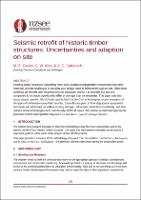| dc.contributor.author | Davies, Matt | |
| dc.contributor.author | Alley, Gareth | |
| dc.contributor.author | Cattanach, Alistair | |
| dc.date.accessioned | 2023-02-21T01:18:16Z | |
| dc.date.available | 2023-02-21T01:18:16Z | |
| dc.date.issued | 2022-04-27 | |
| dc.identifier.uri | https://repo.nzsee.org.nz/xmlui/handle/nzsee/2505 | |
| dc.description.abstract | Existing timber structures, containing more hand-adapted and degradable components than other materials, provide challenges in ensuring your design intent is followed through on site. Often these buildings are flexible with dispersed seismic resistance, and so it is essential that any one component is not made significantly stiffer or stronger than the remainder. This paper uses two recent church retrofits: Old St Paul's and St John’s in the City in Wellington, to give examples of the types of unforeseen issues that can arise. Examples are given of how degradation assessment and repair was addressed, as well as existing damage, unforeseen connection eccentricity, and how modern screw technologies were used to solve difficult issues. The authors recommend appropriate provision of time and expertise required over and above ‘typical’ heritage retrofits. | |
| dc.language.iso | en | |
| dc.publisher | New Zealand Society for Earthquake Engineering | |
| dc.relation.ispartofseries | 2022;133 | |
| dc.subject | Quantifying and addressing uncertainties in seismic design | |
| dc.subject | Case studies of achieving building resilience while accounting for uncertainties | |
| dc.subject | Case studies and research supporting risk mitigation by retrofitting | |
| dc.title | Seismic retrofit of historic timber structures: Uncertainties and adaption on site | |
| dc.type | Article | |

